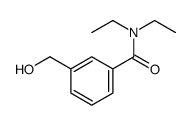ω-Hydroxy-DEET
Modify Date: 2025-08-25 16:04:26

ω-Hydroxy-DEET structure
|
Common Name | ω-Hydroxy-DEET | ||
|---|---|---|---|---|
| CAS Number | 72236-22-7 | Molecular Weight | 207.26900 | |
| Density | 1.082g/cm3 | Boiling Point | 383.1ºC at 760 mmHg | |
| Molecular Formula | C12H17NO2 | Melting Point | N/A | |
| MSDS | N/A | Flash Point | 185.5ºC | |
Use of ω-Hydroxy-DEETω-Hydroxy-DEET is a major metabolite of insect repellent N-N-diethyl-meta-toluamide (DEET). ω-Hydroxy-DEET has anti-proliferative effects. DEET is a spatial repellent and an irritant that commonly used to prevent contact with mosquitoes[1][2][3]. |
| Name | N,N-diethyl-3-(hydroxymethyl)benzamide |
|---|---|
| Synonym | More Synonyms |
| Description | ω-Hydroxy-DEET is a major metabolite of insect repellent N-N-diethyl-meta-toluamide (DEET). ω-Hydroxy-DEET has anti-proliferative effects. DEET is a spatial repellent and an irritant that commonly used to prevent contact with mosquitoes[1][2][3]. |
|---|---|
| Related Catalog | |
| In Vitro | Hepatoma cell studies reveals that ω-Hydroxy-DEET (DHMB; 0.1-10 μg/mL; 48-72 hours) treatments decreases cellular proliferation[1]. |
| In Vivo | The metabolite ω-Hydroxy-DEET (DHMB) is extensively distributed following intravenous and topical skin administration of DEET in rats. The ω-Hydroxy-DEET appeared to be the major metabolite for DEET. Repeated once-daily topical application for 30 days lead to higher concentrations of ω-Hydroxy-DEET in the liver[1]. |
| References |
[3]. Lu W, et al. DEET as a feeding deterrent. PLoS One. 2017 Dec 14;12(12):e0189243. |
| Density | 1.082g/cm3 |
|---|---|
| Boiling Point | 383.1ºC at 760 mmHg |
| Molecular Formula | C12H17NO2 |
| Molecular Weight | 207.26900 |
| Flash Point | 185.5ºC |
| Exact Mass | 207.12600 |
| PSA | 40.54000 |
| LogP | 1.66090 |
| Index of Refraction | 1.542 |
| Hazard Codes | Xn |
|---|
| N,N-diethyl-3-hydroxymethylphenylamide |
| Benzamide,N,N-diethyl-3-(hydroxymethyl) |
| N,N-Diethyl-m-hydroxymethylbenzamide |
| N,N-DIETHYL-3-HYDROXYMETHYL-BENZAMIDE |